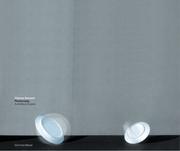| Listing 1 - 3 of 3 |
Sort by
|
Dissertation
Abstract | Keywords | Export | Availability | Bookmark
 Loading...
Loading...Choose an application
- Reference Manager
- EndNote
- RefWorks (Direct export to RefWorks)
Doelstelling: In deze masterproef wordt de vertaling van DDR-realia bestudeerd aan de hand van de Duitse romans "Der Turm" (Uwe Tellkamp) en "Lagerfeuer" (Julia Franck) en de Nederlandse vertalingen ervan: "De Toren" (Goverdien Hauth-Grubben) en "Kampvuur" (Hilde Keteleer). Middelen of methode: Na een korte introductie van beide romans wordt de wetenschappelijke literatuur over realia besproken. Daarin komen enerzijds thematische categorieën, anderzijds categorieën van vertaalstrategieën aan bod. Op basis van deze literatuur (o.a. Van Hende 2005) worden voor beide soorten categorieën parameters opgesteld, aan de hand waarvan het corpus van DDR-realia en hun vertalingen uit fragmenten van beide romans geanalyseerd worden. Ten slotte wordt vergeleken of in beide romans dezelfde realia terugkomen en of ze op dezelfde manier vertaald worden. Resultaten: We kunnen besluiten dat de maatschappelijk-culturele realia de grootste thematische categorie in het corpus vormen en dat voor de vertaling van de meeste DDR-realia in het corpus een letterlijke overname wordt gebruikt. Deze vertaalstrategie komt individueel voor, maar vaak ook in combinatie met andere strategieën.
DDR. --- De Toren. --- Der Turm. --- Julia Franck. --- Kampvuur. --- Lagerfeuer. --- Realia. --- Uwe Tellkamp. --- Vertaalkundige studie – Onderzoek van vertalingen – schriftelijke taal. --- Vertaalstrategie.
Book
ISBN: 1571138552 1283256789 9786613256782 1571137742 1571134212 1571135790 Year: 2011 Publisher: Rochester, NY : Camden House,
Abstract | Keywords | Export | Availability | Bookmark
 Loading...
Loading...Choose an application
- Reference Manager
- EndNote
- RefWorks (Direct export to RefWorks)
After the international success in the 1990s of authors such as Bernhard Schlink, Marcel Beyer, and Thomas Brussig, an impressive number of new German-language novelists are making a significant impact. Some, like Karen Duve, Daniel Kehlmann, and Sasa Stanisic, have achieved international recognition; some, like Julia Franck, have won major prizes; others, like Clemens Meyer, Alina Bronsky, and Ilja Trojanow, are truly "emerging authors" who have begun toattract attention. Between them they represent a range of literatures in German, from women's writing to minority writing (from Turkish immigrants and Eastern Europe), to "pop literature" and perspectives on the former GDR and onGermany's Nazi past. This volume devotes individual essays to fifteen such writers, examining in detail a major work of each. Translated excerpts from works by Vladimir Vertlib and Clemens Meyer round out the book, which willbe of interest not only to academics and students of English and Comparative Literature in the UK, the US, and beyond, but also to the general reader, for whom titles of texts and quotations are translated. Contributors: Lyn Marven, Stuart Taberner, Anke S. Biendarra, Stephen Brockmann, Rebecca Braun, Frauke Matthes, Brigid Haines, Julian Preece, Emily Jeremiah, Valerie Heffernan, Barbara Mennel, Heike Bartel, Kate Roy, Andrew Plowman, Sonja E.Klocke, Jamie Lee Searle, Katy Derbyshire. Lyn Marven is a Lecturer in German at the University of Liverpool. Stuart Taberner is Professor of Contemporary German Literature, Culture, and Society at the University of Leeds.
German fiction --- German literature --- History and criticism. --- Alina Bronsky. --- Clemens Meyer. --- Daniel Kehlmann. --- Former GDR. --- German Literature. --- German-Language Novelists. --- Ilja Trojanow. --- Julia Franck. --- Karen Duve. --- Pop Literature. --- Sasa Stanisic.

ISBN: 3829601719 3902289015 9783829601719 Year: 2004 Publisher: Bregenz München Kunsthaus Schirmer/Mosel
Abstract | Keywords | Export | Availability | Bookmark
 Loading...
Loading...Choose an application
- Reference Manager
- EndNote
- RefWorks (Direct export to RefWorks)
Les photos Thomas Demand sont des photos de recherche. Il est en réalité plutôt un sculpteur. A première vue, c'est le quotidien qui est photographié, mais les clichés sont des constructions, des reconstructions de la réalité. Elle unit l'effet d'une falsification avec le processus de la simulation. Il illustre entre autre des architectures. Après la réalité, un modèle est construit, et la photographie est le document contraignant de ce modèle, dont la réalité sort à nouveau.
Paper sculpture --- Still-life photography --- Staged photography --- Sculpture en papier --- Nature morte --- Photographie mise en scène --- Exhibitions --- Expositions --- Photographie --- Demand, Thomas, --- Exhibitions. --- Demand, Thomas --- Texte von = texts by Ralph Rugoff und = and Julia Franck ; herausgegeben = edited by Eckhard Schneider --- kunst --- twintigste eeuw --- eenentwintigste eeuw --- fotografie --- installaties --- Demand Thomas --- Duitsland --- 77.071 DEMAND --- 7.071 DEMAND --- Photographie mise en scène
| Listing 1 - 3 of 3 |
Sort by
|

 Search
Search Feedback
Feedback About UniCat
About UniCat  Help
Help News
News